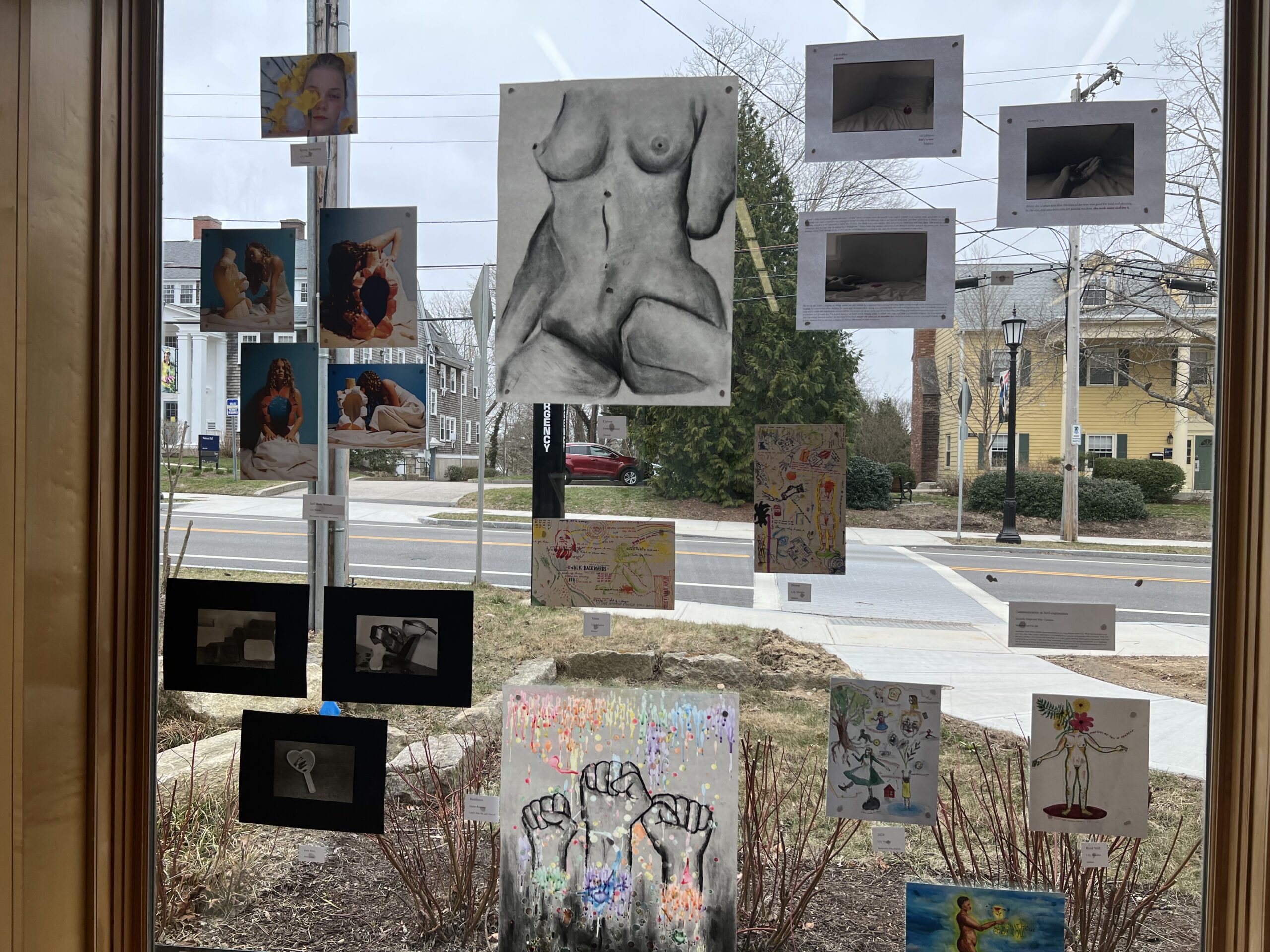Photos of the artwork hanging up in the GSC. PHOTO CREDIT: Ellie Shennhen | Staff Reporter
Themes of self-love, expression and identity were expressed in a multitude of mediums at the University of Rhode Island Gender and Sexuality Center’s exhibit on March 28.
Featuring pieces made from candle wax, charcoal, graphite, hot bronze, ink, marker, paint, colored pencil and watercolor, the gallery was meant to showcase the Center’s vision of a welcoming and inclusive campus community.
“I wanted to bring the community together,” said Emma Rousseau, the exhibit curator and GSC’s mental health and wellness specialist. “I wanted students to be able to show their artwork off somewhere… and include nontraditional themes.”
During the exhibit’s first day on display, the GSC commissioned Agonza, a Latin American Providence-based artist, to paint live in the Center.
Assigned to paint around the theme of identity, Agonza completed her art piece, entitled “Identification of Me, Myself & I,” in two hours and 10 minutes, according to Rousseau. Rousseau stated that Agonza chose to paint herself because she knew that her experience wouldn’t speak to everyone.
Agonza meant to show that “experience is different” through her painting, according to Agonza’s Instagram page. The painting depicts her own growth and change from growing up bisexual in a Latin community.
Agonza is a URI alumna and according to Rousseau, she had a “really bad experience” in her undergraduate years due to little LGBTQIA+ support.
There was no GSC during Agonza’s time at URI, so commissioning her at the Center was a way to show “how much the University has changed… and how much we’re moving forward,” according to Rousseau.
The exhibit also featured several pieces from Rousseau, whose favorite part of the gallery experience was seeing and hearing people’s reactions to the art. Rousseau described people coming in days after the showcase excitedly pointing at fruit drawings that look like vulvas.
“You can really see… and tell a story through art,” Rousseau said. “Especially with the titles of the pieces, I felt like I could understand what [artists] were saying.”
Many pieces in the exhibit aligned with non-traditional realms of inspiration, such as the transgender experience and sexual identity, according to Rousseau. Because these topics are not commonly depicted in art or on campus, she was proud to hear compliments from gallery visitors.
Rousseau created an art piece entitled “Resilience” using candle wax, ink and charcoal for an art class she is currently in, according to her. The art features vulvas, flowers and roots and is part of her honors project, where she is selling art to raise money.
Another piece, “Strawberry Shortcake,” made from colored pencil, newspaper and tape, features a drawing of Rousseau’s own body, with lyrics from Melanie Martinez’s song “Strawberry Shortcake” along the bottom.
“That whole song is about how, typically, men don’t know how to keep their hands off of women,” Rousseau said. “Society doesn’t teach men not to sexually assault women, but instead teaches women to comply or go to self-defense training.”
Rousseau’s last piece in the exhibit, made of charcoal, was entitled “Curves.” For this piece, Rousseau explained how she drew her friend’s body who identifies as gender-queer, and wanted to show that “people’s bodies can look a variety of ways.”
She hopes that the Center’s gallery can also be a place where students can show their pieces to people other than their friends and families — and encourage self-expression and exploration through art.
“Art is so good for expressing emotions and showing them to a wider world,” second-year journalism and gender and women’s studies student Kat Sheridan said. “It’s a way of showing that it’s okay to express the things you might be struggling with yourself. And if you express that, through art, it’s easier for people to be able to come and support you for it.”
Sheridan, who created a piece with acrylic paint entitled “Labels,” stated that it was both “nerve-wracking” and “freeing” to have their art in the GSC gallery.
Identifying as non-binary, Sheridan said that it was tough to decide between the labels ‘bisexual’ and ‘lesbian.’
“Being non-binary [makes] it even tougher, because I’m not a woman,” Sheridan said. “I wanted to show that there are so many labels, and yet it’s still so restricting.”
Having their art displayed in the gallery was a “cool” experience for Sheridan, and hearing that people liked the art was both “exciting” and “vulnerable.”
Galleries that show real struggles are a way to build community because they attract people who have the same mindsets and interests, according to Sheridan.
The gallery featured work from four other URI students: behavioral science graduate student Michelle Stage; third-year communication studies major and GSC Event Planning and Education Specialist Katie Riedy; second-year student El Fernekees; first-year English and gender and women’s studies student Lily Mueller.
“Art is so important for everyone,” Sheridan said.





